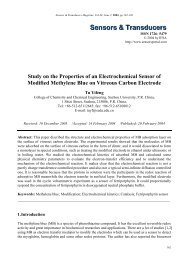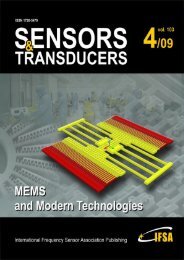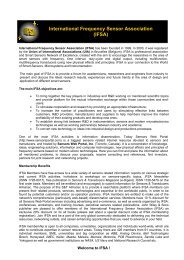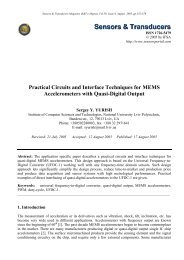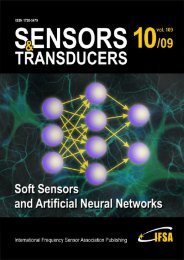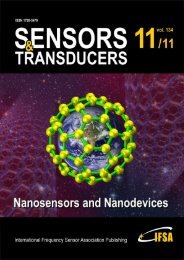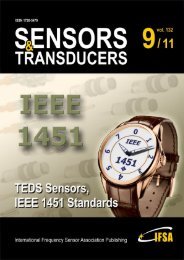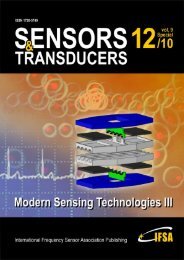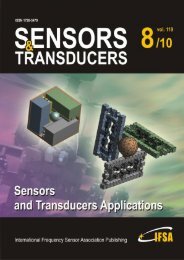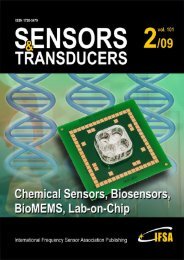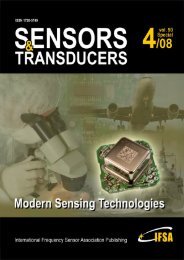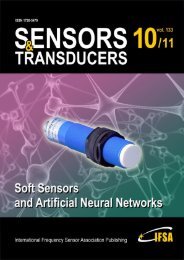Recent Advances in DNA Biosensor - International Frequency ...
Recent Advances in DNA Biosensor - International Frequency ...
Recent Advances in DNA Biosensor - International Frequency ...
You also want an ePaper? Increase the reach of your titles
YUMPU automatically turns print PDFs into web optimized ePapers that Google loves.
Sensors & Transducers Journal, Vol. 92, Issue 5, May 2008, pp. 122-133<br />
4.1. Label Based or Indirect Detection<br />
In label based electrochemical biosensor specific organic dyes, metal complexes or enzymes are used<br />
for hybridization detection. The use of enzyme labeled probe offers great promise for electrochemical<br />
detection of <strong>DNA</strong> hybridization [28]. On addition of substrate to the enzyme modified electrode<br />
surface, the electrochemical activity of the product simplifies the detection of hybridization [54].<br />
Redox- active molecules such as daunomyc<strong>in</strong>, methylene blue which is <strong>in</strong>serted between the ds<strong>DNA</strong><br />
and gives signal which can be used for hybridization detection [54, 65]. Redox-active molecules based<br />
two commercialized <strong>DNA</strong> chips have been <strong>in</strong>troduced <strong>in</strong> molecular diagnosis market <strong>in</strong> the trade name<br />
of eSensor TM produced by Motorola Life sciences [25], Inc. and Genlyser TM by Toshiba [26].<br />
4.2. Label Free or Direct Detection<br />
Contrary to <strong>in</strong>direct detection techniques, where label<strong>in</strong>g is a requirement to translate the hybridization<br />
event <strong>in</strong>to a signal, <strong>in</strong> direct detection techniques, a target molecule or any other object from the<br />
system does not need to be labeled [55, 54].Although label-dependent methods achieve the highest<br />
sensitivities, elim<strong>in</strong>at<strong>in</strong>g the label<strong>in</strong>g steps simplifies the readout, the speed and ease of nucleic acid<br />
assays.<br />
In a label-free method the immobilized probe recognizes a complementary sequence if the target is<br />
present <strong>in</strong> the sample. Next, the transducer converts the biological <strong>in</strong>teraction <strong>in</strong>to a measurable signal,<br />
proportional to the degree of hybridization that is to the amount of target molecule <strong>in</strong> the sample.<br />
Label-free strategies reduce analysis times and cost. They are also free from unfavorable effects from<br />
the labels, such as its <strong>in</strong>stability and steric h<strong>in</strong>drances.<br />
<strong>Recent</strong>ly, a new label-free electrochemical detection technique has been developed which is faster and<br />
simpler [14, 15, 45, 47, 53]. It is possible to exploit changes <strong>in</strong> the <strong>in</strong>tr<strong>in</strong>sic electroactivity of <strong>DNA</strong><br />
(guan<strong>in</strong>e oxidation peak of hybridization). To overcome the limitations of the probe sequences<br />
(absence of G), guan<strong>in</strong>es <strong>in</strong> the probe sequence were substituted by <strong>in</strong>os<strong>in</strong>e residues (pair<strong>in</strong>g with C)<br />
and the hybridization was detected through the target <strong>DNA</strong> guan<strong>in</strong>e signal [15, 53].Changes <strong>in</strong> the<br />
guan<strong>in</strong>e oxidation, and of other <strong>in</strong>tr<strong>in</strong>sic <strong>DNA</strong> redox signals, have thus been used for detect<strong>in</strong>g<br />
chemical and physical damage. A greatly amplified guan<strong>in</strong>e signal, and hence hybridization response,<br />
was obta<strong>in</strong>ed by us<strong>in</strong>g the Ru(bpy) 3 redox mediator. Direct, label-free, electrical detection of <strong>DNA</strong><br />
hybridization has also been accomplished by monitor<strong>in</strong>g changes <strong>in</strong> the conductivity of conduct<strong>in</strong>g<br />
polymer molecular <strong>in</strong>terfaces (<strong>DNA</strong>-modified polypyrrole films). Eventually, it would be possible to<br />
elim<strong>in</strong>ate these polymeric <strong>in</strong>terfaces and to exploit different rates of electron-transfer through ss <strong>DNA</strong><br />
and ds <strong>DNA</strong> for prob<strong>in</strong>g hybridization (<strong>in</strong>clud<strong>in</strong>g mutation detection via the perturbation <strong>in</strong> charge<br />
transfer through <strong>DNA</strong>).<br />
5. Piezoelectric <strong>DNA</strong> <strong>Biosensor</strong><br />
Piezoelectric <strong>DNA</strong> biosensor is based on quartz crystal that oscillate at a def<strong>in</strong>ed frequency when an<br />
oscillat<strong>in</strong>g voltage is applied, allow<strong>in</strong>g high sensitivity. Piezoelectric method has recently emerged as<br />
most attractive due to their simplicity, cost, sensitivity and real time label-free detection [20, 55, 66,<br />
67]. The quartz crystal microbalance (QCM) is an extremely sensitive mass-measur<strong>in</strong>g device that<br />
allows dynamic monitor<strong>in</strong>g of hybridization events. QCM hybridization biosensors consist of an<br />
oscillat<strong>in</strong>g crystal with the <strong>DNA</strong> probe immobilized on its surface. The <strong>in</strong>creased mass, associated<br />
with the hybridization reaction, results <strong>in</strong> a decrease of the oscillat<strong>in</strong>g frequency. A highly-sensitive<br />
microgravimetric device was developed for detect<strong>in</strong>g the TaySachs genetic disorder. QCM transducers<br />
127



